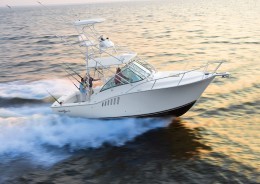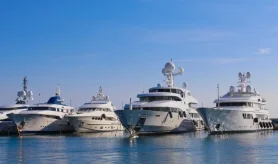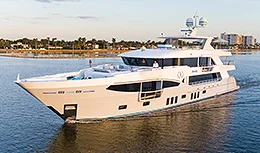- Alaskan Yachts
- Azimut Yachts
- Back Cove Yachts
- Beneteau Yachts
- Benetti Superyachts
- Bertram Yachts
- Boston Whaler
- Broward Yachts
- Buddy Davis Sportfish
- Burger Yachts
- Cabo Yachts
- Catamarans
- Carver Motoryachts
- Center Console
- Chris-Craft Yachts
- Cruisers Yachts
- DeFever Trawlers
- Dufour Sailboats
- Fairline Yachts
- Feadship Yachts
- Ferretti Yachts
- Filippetti Yachts
- Formula Yachts
- Fountaine Pajot Cats
- Grady-White
- Grand Banks Trawlers
- Hargrave Yachts
- Hatteras Yachts
- Hinckley Picnic Boats
- Horizon Yachts
- Hydra-Sports
- Intrepid Boats
- Jarrett Bay Sportfish
- Jeanneau Yachts
- Kadey-Krogen Trawlers
- Lazzara Yachts
- Lekker Boats
- Luhrs Sportfish
- Marlow Yachts
- Maritimo Yachts
- Marquis Yachts
- Mazu Yachts
- McKinna Motoryachts
- Meridian Yachts
- Midnight Express
- MJM Yachts
- Mochi Craft
- Neptunus Motoryachts
- Nordhavn Trawlers
- Nordic Tugs
- Numarine Yachts
- Ocean Alexander Yachts
- Ocean King
- Offshore Yachts
- Outer Reef
- Oyster Sailing Yachts
- Pacific Mariner Yachts
- Palmer Johnson Yachts
Albemarle 290XF
![]()
 Source: Captain Bill Pike, Power & Motor Yacht
Source: Captain Bill Pike, Power & Motor Yacht
When the first sailfish hit, we were running along the eastern edge of the Gulf Stream. The day was perfect, with the wind northerly, seas averaging six feet or more, and the sun bearing down just hard enough to ease the mid morning January chill. “Right kite,” yelled Albemarle company captain Jamie Brandon from the cockpit of our Albemarle 290XF (Express Fisherman).
I’d been day dreamin’ some. You know how us older guys are—we fall into the occasional reverie, especially when the light’s low and lays on the water just so. “Bill!” yelled Brandon again, putting some pizazz into it this time. I lunged for the rod in one of the port-side rod holders, a feisty stand-up stick with a Sealine 40 HSD reel on the business end and a hefty slug of 20-pound mono already freespooling into the ether.
About the time I shoved the rod’s butt into my stomach and snatched back, the fish blasted from the face of a gray roller like he was sent for. I yelped, cranking slack until I could feel the squeeze of the Daiwa’s drag. The vision that shortly evolved was one I’ll have no trouble seeing in my mind’s eye 20 years from now. The graceful silver fish began leaping like a greyhound amid the peaks and valleys, with shots of sunshine turning the monofilament between us into a shining gossamer thread.
The fight was on! With shouts from Brandon and my legs braced against the optional coaming pad, I muscled straight into the give and take that landing a fair-size sailfish calls for. Frothy waters thrashed at the transom, and the roar of the boat’s twin 315hp Yanmars rose and fell as we charged backwards. Albemarle’s marketing guy, Ted Haigler, stood with his rear against the pod-type steering station, a Palm Beach-style engine-control lever in each hand, working the Konzaki gears with a will.
What a boat! This sentiment came to me twice during the ensuing 15 minutes: once as Haigler twin-screwed an abrupt right-hand turn while going dang-near full astern, and again as he chased the fish in a big, backwards-plowing circle. “Hang in there!” Haigler yelled before barreling into the first maneuver, and “One more time, Bill,” as he initiated the second.
The sticky softness of the coaming pad helped me stay upright throughout all the dodging and feinting, as did the no-nonsense nonskid under my deck shoes and the beamy breadth of the 29, a feature that produces just enough transverse stability to keep a guy solidly in the cockpit while both his hands are occupied with tasks vastly more compelling than plain ol’ hangin’ on for dear life.
We ultimately boated the rambunctious little sail (a 60-pounder by onboard estimate), took a few pictures, and promptly released him. Then we tangled with a couple more catch-and-release sails, one slightly larger than our first, and another grandiose tail-walker we all pegged at about 80 pounds before he pulled the hook. Moreover, we caught some sharks and a fair-size dolphin.
As if our test boat hadn’t already shown her stuff and then some, she made the trip back to Lake Worth Inlet in full battlewagon style, despite the six- to eight-footers whopping her starboard quarter all the way. Tracking was straight, with little yaw to contend with, most likely due to a nose-up running attitude at two-thirds throttle and the focused thrust tunnels engender. The ride was bone-dry, even when bottoming out in troughs, thanks to the Carolina flare that Albemarle touts. And the heft of the vessel was apparent every time we split the back of a roller.
This last point’s important. Albemarle bills the 290 as an entry-level offshore sportfisherman, albeit a serious one with a serious price tag. So we’re talkin’ a full-up weight of approximately 15,000 pounds—that’s with full fuel and water tanks, a topped-off livewell, and a few folks onboard. Such a number blows past the full-up weight of a 30-foot mainstream cruiser by a couple of tons, at least.
Where do the extra pounds come from? Albemarle’s Scott Wildermuth drew the 290 and spearheaded her development in accordance with an old-school aphorism: “The more glass, the better.” Consequently, he specified a gutsy, 9⁄16-inch-thick, solid-glass bottom skinned with both a vinylester barrier layer and a layer of premium Armorcote gelcoat from Cook Composites & Polymers. In addition, he specified Divinycell foam-cored hull sides that are approximately one inch thick, a deck sandwiched with the same coring material that’s 11⁄4 inches thick, and stringers and transversals composed of two thicknesses of lifetime-guaranteed, 3⁄4-inch XL marine ply, glass-encapsulated. Add to this prodigious melange a shoebox-type hull-to-deck joint secured with stainless steel bolts on six-inch centers and heavily bonded with fiberglass, and it’s no wonder the 29 tips the scales with such gusto.
We did a second sea trial several days later in Miami because immediately after returning from offshore, I noticed that the top-end speeds we were getting in Lake Worth seemed low and our engines were turning almost 300 rpm below Yanmar’s full-throttle spec. Moreover, the boat maneuvered sluggishly while I backed her into her slip at Sailfish Marina in Palm Beach. The problem? “Bottom needs cleanin’,” Haigler and Brandon agreed.
The test data from the second trial in flat-calm water turned out more realistically. Our Yanmars spun an appropriate rpm, thanks to a freshly pressure-washed running surface, the average top speed of 34.3 mph was cool, over-the-bow visibility from the lofty Pompanette helm chair was fine despite the equally lofty running attitudes coming out of the hole, and dockside maneuvering was quick and agile. “Now that’s more like it,” I concluded.
This lovely outcome was gratifying on three counts. First, I’d already gotten down with the 290’s oomph and stoutness by this stage of the game, despite the disappointing initial performance results. Indeed, my offshore experiences onboard had engendered one telling observation: Of all the several boats plying the cold coastal Atlantic the morning I snagged all the dang fish, ours was by far the smallest.
Second, I’d also become a fan of the 290’s engineering. She offers an offshore-capable machinery space under a push-button-liftable helm. Air intakes replicate those on big-leaguers, the centerline genset’s in the engine room, not in a damp, salty lazarette, and the distance between the mains exceeds shoulder-width (just a tad better than 20 inches), a significant detail for do-it-yourselfers who deal with filter elements, sea strainers, and oil changes. The absence of a centerline walkway is my only complaint—I had to stand unsteadily atop battery boxes between the inboard engine bearers to look around.
And third, the serviceable simplicity of the 290’s interior had pretty much caught my fancy as well. The boat’s below-decks layout is easily maintained and basic, with little more than a V-berth forward, a galley to port, and a wet head to starboard. Extra bunks over the V-berth quickly deploy from fold-away positions against the hull sides.
A rush to judgment in all three cases? Hmm, maybe. But catching three sails in four hours is likely to mess with anybody’s mind. Even a wily old boat tester’s.
Specifications: Albemarle 290XF 2008
Boat Type: Express Sportfisherman
Standard Power: 2/315-hp Yanmar 6LPA-STP diesel inboards
Optional Power: 2/370-hp MerCruiser 8.1 Horizon gasoline inboards or 350-mhp Cummins MerCruiser QSD4.2-350 diesel inboards
Length Overall (LOA): 30’6″
Beam: 10’9″
Draft: 2’8″
Weight: 12,500 pounds (dry)
Fuel Capacity: 265 gallons
Water Capacity: 28 gallons
Standard Equipment: Edson wheel; Pompanette helm chairs; Imtra windshield wipers; Corian countertops; Tappan microwave oven; Iso-Therm refrigerator; Fireboy smoke/fire/CO detector; Paneltronics electrical panels; 3/Group 31 batteries (2/engine and 1/house); Racor 900MA water-fuel separators (main engines); Tides Marine dripless shaft logs; Groco interior-type sea strainers; Fireboy FE241 fire-ext. system; Bennett trim tabs
Test Engines: 2/315-hp Yanmar 6LPA-STP diesel inboards
Transmissions / Ratio: Konzaki KMH50A/2.40:1
Props: 21×26 four-blade nibral
Steering: Teleflex Sea-Star hydraulic (no power-assist)
Controls: Glendinning electronic w/ Palm Beach-style levers
Optional Equipment On Test Boat: Lee Millenium Series outriggers; Ashley Welding tower w/full enclosure; Jensen TV and DVD/CD player; 4-kW Fischer Panda genset; 7,000-Btu A/C system; coaming pads; Maxwell Freedom 500 windlass w/ ground tackle; hull color; teak-and-holly sole



